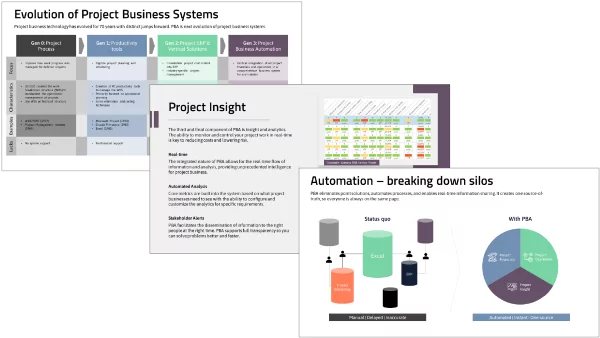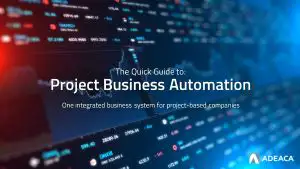Building a Strong Foundation for Success
In the world of project business, having the right systems in place is crucial for success. That’s where Project Business Systems come into play. This emerging category of business systems is specifically designed to meet the unique needs of enterprises running projects. If you are a project-based company or have projects that are vital to your company, it only makes sense to utilize a project business system to streamline your operations and maximize efficiency.
Key Components of a Project Business System
A robust project business system comprises various key components that work together to ensure seamless project management, financial control, operational efficiency, and informed decision-making. Let’s explore these essential components in detail:
Project Financials:
In the realm of project business, effective financial management is vital. A comprehensive project business system should include:
- Estimating and budgeting (project modeling), allowing project managers to accurately forecast and allocate money and resources.
- Cost Breakdown Structure (CBS) to track expenses across different project components.
- Key financial elements such as EAC (Estimate at Completion), BAC (Budget at Completion), EVA (Earned Value Analysis),
- Tracking of actuals, billing, revenue recognition, time and expense, subcontracts
- Robust change management
All of these components and more should be integrated within the system to ensure robust financial control and compliance.
Project Operations:
Efficient project operations are essential for timely project completion and optimal resource utilization. A project business system should facilitate the following:
- Effective scheduling based on a Work Breakdown Structure (WBS), enabling project managers to define project tasks, dependencies, and timelines.
- Progress tracking features to allow real-time monitoring of project milestones and deliverables.
- Resource management functionality to ensure the right allocation of personnel, skills, and equipment.
- Capacity planning to balance workload and identify resource constraints.
- Material planning and supply chain tracking capabilities to enable streamlined procurement and inventory management driven by the project.
- RAIDO (Risks, Assumptions, Issues, Dependencies, and Opportunities) to enhance risk mitigation strategies.
Project Insight:
To make informed decisions and monitor project performance effectively, project insight features are essential. A project business system should provide:
- Management reports that offer comprehensive visibility into project status, financial health, and progress against key performance indicators.
- Cash flow tracking of cash inflows and outflows throughout the project lifecycle.
- Margin and variance analysis to monitor project profitability and identify areas of improvement.
- Portfolio analytics for a holistic view of multiple projects, helping in resource optimization and strategic decision-making.
- Automated alerts and notifications to ensure information is disseminated to stakeholders in a timely fashion, enabling proactive decision-making.
By incorporating these key components into a project business system, organizations can streamline their project management processes, enhance financial control, optimize resource allocation, and gain valuable insights for improved decision-making. Whether it’s estimating project costs, tracking progress, or analyzing project performance, a comprehensive project business system empowers project-based businesses to achieve success and deliver exceptional results.
Project Business Automation
Project Business Automation (PBA) is a specialized project business system designed to streamline project management processes by standardizing, integrating, and automating them within a single unified platform. This comprehensive solution effectively tackles the complexities of project management for enterprises, providing the financial and operational tools, controls, and insight to optimize the project lifecycle across the organization.
PBA is the first vertically integrated business system for projects
Industry experts, such as Forrester, have recognized PBA as the new paradigm for project business management, highlighting its transformative capabilities.
By placing projects at the forefront, PBA seamlessly integrates business and operational aspects, enabling project-based companies to optimize their operations and achieve greater efficiency. Manual tasks are automated, reducing errors and increasing productivity. The result is faster project completion, improved resource utilization, better risk mitigation, and lower costs.
Download the Project Business Automation Quick Guide
The Project Business System Approach
One of the key challenges for project businesses is to prioritize the enterprise’s core needs effectively. Often, companies in this industry tend to focus too much on peripheral aspects of their business processes, neglecting the foundational elements that form the backbone of their operations. This can lead to a subpar system that fails to address the critical requirements of the enterprise.
Neglecting the foundational elements of your operations can lead to a subpar system.
For example, let’s consider a construction company that becomes fixated on finding a system capable of managing Building Information Modeling (BIM) documents. While this is an important aspect, basing the entire system decision solely on this need can result in overlooking other vital components necessary for the smooth functioning of the business.
How your project business system relates to other systems
The key to success for project businesses lies in adopting a bottom-up approach (see graphic below). As a project business, it is essential to prioritize and address the foundational elements of your company. This foundational layer should encompass all the necessary components seamlessly integrated into one holistic system as described above, effectively meeting the majority of your needs.
You can establish this foundational layer at the same time, before, or after you focus on the business functional layer. This layer typically encompasses standard Enterprise Resource Planning (ERP) functionality. For larger companies, opting for a tier-1 enterprise-level system like Microsoft Dynamics 365 Finance, SAP, or Oracle is crucial to ensuring stability, longevity, and extensibility.
The key point here is that your project business system does not need to be your ERP. Rather, it should be self-contained and summarize and exchange critical information with your ERP. The ability to easily integrate with your ERP ensures consistent and automated workflows across your business.
Lastly, addressing specific industry requirements can be achieved through platform extensions, add-ons, or customizations. It is important to treat these needs as extensions rather than core platform requirements, allowing for the selection of a comprehensive and stable system that can be customized and extended to meet long-term business needs.
Conclusion
In conclusion, Project Business Systems offer project-based businesses a tailored solution to optimize their operations. By adopting a bottom-up approach and prioritizing the foundational elements, companies can build a robust and future-proof system that drives success and growth. Invest in the right project business system today, like PBA, and unlock the true potential of your project-based enterprise.











